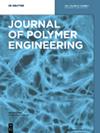Fabrication and characterization of microencapsulated dimethyl adipate phase change material with melamine-formaldehyde shell for cold thermal energy storage in coating
IF 1.7
4区 工程技术
Q4 POLYMER SCIENCE
引用次数: 0
Abstract
Abstract Microencapsulated phase change material (MPCM) was synthesized by using the in-situ polymerization technique. Dimethyl adipate (DMA) and melamine-formaldehyde were used as core and shell material for polymerization respectively. Sodium laureate sulphate (SLS) is used as a surfactant. The thermal properties were characterized by using a differential scanning calorimeter (DSC) and thermogravimetry analysis (TGA). Fourier transform infrared spectroscopy (FT-IR) was used to confirm the chemical structure. The morphology of microcapsules was studied by using, scanning electron microscopy. DSC result of MPCM has been observed to melt at 10.09 °C with melting latent enthalpy 88 J/g and crystallizes at 4.69 °C with crystallization latent heat 89.50 J/g. TGA analysis confirms increases in the thermal stability of MPCM. The decorative coating was prepared with 0, 5, 10, 15, and 20 % MPCM loading, and the prepared paint was tested for pencil hardness, gloss, and stain resistances. The thermal energy transfer rate was used to measure how much time coated panel took to reach the equilibrium temperature of 25 °C. Coating with 20 % MPCM loading revealed good thermal storage capacity but other general coating properties deteriorate.涂层用三聚氰胺-甲醛壳微囊化己二酸二甲酯相变材料的制备与表征
摘要采用原位聚合技术合成了微胶囊相变材料。分别以己二酸二甲酯(DMA)和三聚氰胺甲醛为核材料和壳材料进行聚合。桂冠硫酸钠(SLS)被用作表面活性剂。利用差示扫描量热仪(DSC)和热重分析(TGA)对其热性能进行了表征。傅立叶变换红外光谱(FT-IR)用于确认化学结构。用扫描电子显微镜对微胶囊的形貌进行了研究。MPCM的DSC结果已观察到在10.09熔融 °C,熔融潜热88 J/g,在4.69下结晶 °C,结晶潜热89.50 J/g。TGA分析证实MPCM的热稳定性增加。用0、5、10、15和20制备装饰涂层 % MPCM负载,并测试所制备的涂料的铅笔硬度、光泽度和耐污性。热能传递率用于测量涂层面板达到25的平衡温度所需的时间 °C。涂20 % MPCM负载显示出良好的储热能力,但其他一般涂层性能恶化。
本文章由计算机程序翻译,如有差异,请以英文原文为准。
求助全文
约1分钟内获得全文
求助全文
来源期刊

Journal of Polymer Engineering
工程技术-高分子科学
CiteScore
3.20
自引率
5.00%
发文量
95
审稿时长
2.5 months
期刊介绍:
Journal of Polymer Engineering publishes reviews, original basic and applied research contributions as well as recent technological developments in polymer engineering. Polymer engineering is a strongly interdisciplinary field and papers published by the journal may span areas such as polymer physics, polymer processing and engineering of polymer-based materials and their applications. The editors and the publisher are committed to high quality standards and rapid handling of the peer review and publication processes.
 求助内容:
求助内容: 应助结果提醒方式:
应助结果提醒方式:


